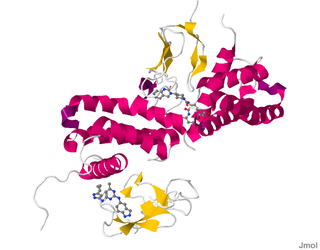
Receptor activity modifying protein 2, also known as RAMP2, is a protein which in humans is encoded by the RAMP2 gene.

The bombesin receptor subtype 3 also known as BRS-3 or BB3 is a protein which in humans is encoded by the BRS3 gene.

The gastrin-releasing peptide receptor (GRPR), now properly known as BB2 is a G protein-coupled receptor whose endogenous ligand is gastrin releasing peptide. In humans it is highly expressed in the pancreas and is also expressed in the stomach, adrenal cortex and brain.

Glucagon-like peptide-2 receptor (GLP-2R) is a protein that in human is encoded by the GLP2R gene located on chromosome 17.

Calcitonin receptor-like (CALCRL), also known as the calcitonin receptor-like receptor (CRLR), is a human protein; it is a receptor for calcitonin gene-related peptide.

N-formyl peptide receptor 3 (FPR3) is a receptor protein that in humans is encoded by the FPR3 gene.

Neuropeptide Y receptor type 2 (Y2R) is a member of the neuropeptide Y receptor family of G-protein coupled receptors, that in humans is encoded by the NPY2R gene.

Probable G-protein coupled receptor 146 is a protein that in humans is encoded by the GPR146 gene.The receptor has been shown to bind a gut-derived hormone called cholesin/C17orf50 in response to dietary cholesterol. Consistent with this interaction, murine genetic disruption of GPR146 lowers serum cholesterol and reduces atherosclerotic aortic lesions. It has also been identified as a possible receptor for C-peptide.

Relaxin/insulin-like family peptide receptor 4, also known as RXFP4, is a human G-protein coupled receptor.

The 5-HT7 receptor is a member of the GPCR superfamily of cell surface receptors and is activated by the neurotransmitter serotonin (5-hydroxytryptamine, 5-HT). The 5-HT7 receptor is coupled to Gs (stimulates the production of the intracellular signaling molecule cAMP) and is expressed in a variety of human tissues, particularly in the brain, the gastrointestinal tract, and in various blood vessels. This receptor has been a drug development target for the treatment of several clinical disorders. The 5-HT7 receptor is encoded by the HTR7 gene, which in humans is transcribed into 3 different splice variants.

Protein kinase C iota type is an enzyme that in humans is encoded by the PRKCI gene.

Protein AATF, also known as apoptosis-antagonizing transcription factor is a protein that in humans is encoded by the AATF gene.

Minor histocompatibility antigen H13 is a protein that in humans is encoded by the HM13 gene.

Neuropeptide FF is a mammalian amidated neuropeptide originally isolated from bovine brain and characterized as a pain-modulating peptide, with anti-opioid activity on morphine-induced analgesia.

Tuberoinfundibular peptide of 39 residues is a protein that in humans is encoded by the PTH2 gene.

Tachykinin-4 is a protein that in humans is encoded by the TAC4 gene.

M-phase phosphoprotein 8 is an enzyme that in humans is encoded by the MPHOSPH8 gene.

Mitochondrially encoded 16S RNA is the mitochondrial large subunit ribosomal RNA that in humans is encoded by the MT-RNR2 gene. The MT-RNR2 gene also encodes the Humanin polypeptide that has been the target of Alzheimer's disease research.

Humanin is a micropeptide encoded in the mitochondrial genome by the 16S ribosomal RNA gene, MT-RNR2. Its structure contains a three-turn α-helix, and no symmetry.

MT-RNR2-like 6 is a protein that in humans is encoded by the MTRNR2L6 gene.
















